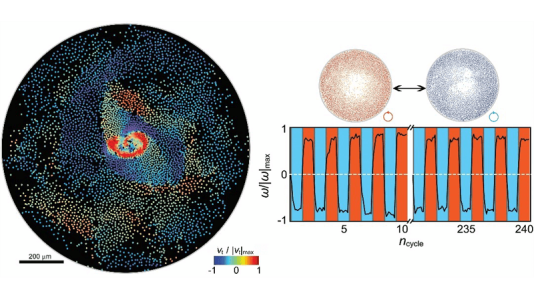
Scientific Achievement
The evidence of a collective state memory in active liquids has been revealed. Systematic control over subsequent self-organized polar states via temporal modulation of the activity is realized.
Significance and Impact
The work provides fundamental insights into the emergence of spatial and temporal coherence in active liquids, and suggests new design pathways for control of dynamic collective states by activity modulations.
Research Details
- Quincke rollers emerge due to spontaneous dielectric particle rotations in a static electric field.
- Interplay of hydrodynamic and electrostatic interactions creates hidden asymmetries in the local particle positional order encoding the global chiral state of the system.
- Complex collective behavior is captured by a particle-based simulation model of Quincke rollers suspensions.
Argonne National Laboratory seeks solutions to pressing national problems in science and technology. The nation’s first national laboratory, Argonne conducts leading-edge basic and applied scientific research in virtually every scientific discipline. Argonne researchers work closely with researchers from hundreds of companies, universities, and federal, state and municipal agencies to help them solve their specific problems, advance America’s scientific leadership and prepare the nation for a better future. With employees from more than 60 nations, Argonne is managed by UChicago Argonne, LLC for the U.S. Department of Energy’s Office of Science.
The U.S. Department of Energy’s Office of Science is the single largest supporter of basic research in the physical sciences in the United States and is working to address some of the most pressing challenges of our time. For more information, visit https://energy.gov/science.